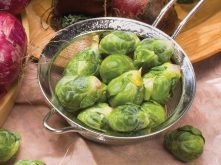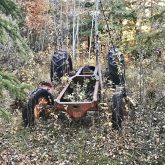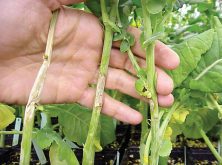Once in a while I try to respond to the proverbial “mailbag” to acknowledge comments, updates and sometimes criticisms of my wide-ranging observations. So here are a few thoughts that readers shared, in no particular order:
Clubroot reminder
I had to tone this down a bit, but after a few articles I wrote on risk and management of clubroot in canola I had a call from Ieuan Evans, plant pathologist in Alberta and Grainews columnist, who clearly made the point, in his view don’t listen to any specialists who tells you to start growing clubroot resistant canola varieties after clubroot has been identified in your fields, particularly in high risk areas. Evan’s message is: start growing it now before clubroot becomes a problem.
Read Also

Gentle treatments for pain in the neck
Heading toward year-end, people unknowingly tense up against the cold and busyness, causing neck pain that can often be treated with appropriate support and gentle mobility, athletic therapist Kathlyn Hossack says.
Love those Americans
I received a letter from Harvey and Bonnie Sangster of Kenton, Man., some time ago now, who didn’t like a column I wrote concerning the new NAFTA deal in which I adopted a Donald Trump approach saying in the absence of facts (who needs facts) I thought the deal was stupid, the worst deal ever in the four-billion-year history of the earth. I believe the Sangsters may have missed the point of my sarcasm. I have no problem with the American people (I think it is a great idea if Canada buys Montana), but I believe their president is extremely annoying, the worst president ever in the four-billion-year history of the earth. That may be a bit harsh, so let’s go with three billion years.
On-line shopping has limits
I received an email from Bob Gilmour of Carrot River in northeast Saskatchewan, after I wrote a column on the convenience and high-risk addictive nature of on-line shopping. It is so easy in Calgary.
Bob reported a different situation in rural Saskatchewan. “Shopping on-line in rural Saskatchewan is not easy,” says Gilmour. “I live in Carrot River and on-line shopping can work at times but can also be impossible.” He was recently looking for a household item he couldn’t find in the town of about 1,000 people. “I tried a couple of stores in Winnipeg and one in Yorkton. No luck. Tried wayfair.ca. They would not accept delivery to a post office box and nobody wants to deliver to my real address, SW8-49-10-W2. We have ordered books from one of the big online places and were turned down for the same reason.
“I finally got (the household item) shipped to my daughter and husband in Prince Albert and now we have to get it from there to here. We are two hours to Prince Albert, three to four hours to Saskatoon, and four to five hours to Regina. However the fishing is good up here.”
I haven’t been to Carrot River yet, (its named after the Plains Creek word for river of wild carrots — also known as Queen Anne’s Lace) but apparently they had alligators there about 90 million years ago — check out the fossil of Big Bert.
I haven’t formalized any plans with Bob Gilmour but the next time he is ordering a book on-line he could have it delivered to me Calgary and I could deliver it to Carrot River on the condition he can find me a fish at Tobin Lake.
More history with cheese
And after a column on the big, wide, whacky wonderful world of cheese in the February 12 issue, I received a note from Duane McCartney, a long-time, now-retired Agriculture Canada Forage Beef Systems Research Scientist at Lacombe, Alta. His early life was touched by cheese as well.
Duane wrote to say, “I really liked your ‘Travel the world for a great cheese.’ I grew up in southern Ontario (near Dorchester just east of London) and my family had the last remaining privately owned raw milk cheddar cheese factory which closed in 1979. With raw milk cheddar we had to age it 60 days before it could be sold. Coloured cheese was sold for new and medium and non-coloured white was kept for old. We tried to keep the old for a year or two but that depended upon supply and demand.
“My dad’s work day was very long. Seven days a week, he would be up at 6 a.m. to stoke the boiler and get ready to receive the farmers milk which was delivered in 80 and 100 pounds cans. With the change to bulk tanks we lost many farmer suppliers to the more lucrative fluid milk prices in London. His day would end between 8 and 9 p.m. after the day’s cheese had been banded with cheesecloth and re-pressed in the 90 pound rounds. Most of our cheese was sold to Ingersoll Cream Cheese processing plant but we had a lot of local customers coming to our factory. You wrote: ‘And whether it is mild, medium or old it all tastes about the same.’ That’s because the milk has been pasteurized and each batch of cheese will taste the same.
“With raw milk cheese, no two batches or ‘makes’ as it was called, taste the same. Our customers would want to taste the cheese before they bought and we would scrape the cheese to give them a taste. I remember selling cheese for $0.63/pound, a far cry from the $10 a pound you mention in your story. We did have some cheese that was 10 to 13 years old. We were stuck with it when a big pizza chain in Toronto reneged on their contract. I was in university at the OAC at the time and I dreamed up the idea of selling it as Moose Milk Cheese and was able to sell a lot to gullible fishermen and hunters especially on Saturdays.”
Duane opted for the easy life of forage and beef research scientist, while I have coasted through many years as a farm writer, leaving Mr. Kraft, Mr. Armstrong and others to toil over the cheese vat.















